Keeping your guitar in top playing condition involves regular maintenance, and one of the most crucial tasks is restringing. Fresh strings can dramatically improve your guitar’s tone, making it sound brighter and more resonant. Whether you’re a beginner or a seasoned player, knowing how to restring your guitar is an essential skill. This guide will walk you through each step of the process, ensuring your instrument is ready to play its best.
Step 1: Prepare Your Workspace and Gather Supplies
Before you begin, find a clean, flat surface to work on. It’s also a good idea to have a soft cloth or guitar mat to protect your instrument’s finish. Gather everything you’ll need:
- New guitar strings (of your preferred gauge and type)
- String winder (optional, but highly recommended for speed)
- Wire cutters
- Tuner
- Fretboard cleaner and lemon oil (for dark wood fretboards like rosewood or ebony)
- Cleaning cloth
Step 2: Remove the Old Strings
Start by detuning your strings until they are slack. This reduces tension on the neck and bridge, making removal easier and safer. Using a string winder or your fingers, unwind the strings at the tuning pegs. Once loose, you can snip the strings with wire cutters for easier removal. Be careful not to scratch your guitar while cutting. Remove the strings from both the tuning pegs and the bridge. For acoustic guitars with bridge pins, gently pull out the pins and remove the ball end of the strings.
Step 3: Clean Your Guitar
With the strings off, this is the perfect opportunity to clean parts of your guitar that are normally inaccessible. Use a soft cloth to wipe down the body, neck, and headstock. Pay particular attention to the fretboard, bridge, and soundhole area, removing any dust or grime.
 Close-up of guitar cleaning process, highlighting fretboard and body
Close-up of guitar cleaning process, highlighting fretboard and body
Step 4: Condition the Fretboard (If Necessary)
If your guitar has a dark wood fretboard like rosewood or ebony, and it appears dry, you can apply a small amount of lemon oil to hydrate the wood. Place a few drops of lemon oil on a clean cloth.
 Applying lemon oil to a rosewood guitar fretboard with a cloth
Applying lemon oil to a rosewood guitar fretboard with a cloth
Step 5: Apply Lemon Oil to the Fretboard
Gently work the lemon oil into the fretboard wood, moving up and down the neck. Don’t saturate the wood; a light application is sufficient. Allow the oil to soak in for about 30 seconds.
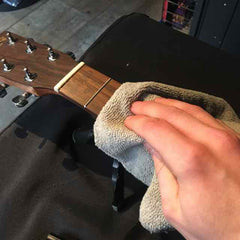 Lemon oil being worked into the guitar fretboard evenly
Lemon oil being worked into the guitar fretboard evenly
Step 6: Hydrate the Bridge (Optional)
If your guitar bridge also looks dry, you can lightly hydrate it with lemon oil as well. However, if you have a saddle installed, it’s best to remove it first or avoid applying lemon oil directly to the saddle, as it can cause strings to slip.
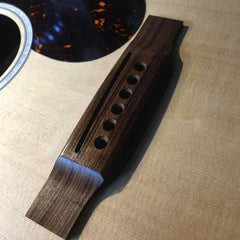 Hydrating a guitar bridge with lemon oil, avoiding the saddle area
Hydrating a guitar bridge with lemon oil, avoiding the saddle area
Step 7: Prepare Your New Strings
Open your new set of guitar strings and identify the correct order. String packs are usually arranged in order, from thickest to thinnest. Familiarize yourself with the string gauges and their positions on your guitar (E-A-D-G-B-e from thickest to thinnest).
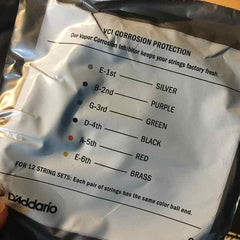 New guitar string pack opened, showing string order and gauges
New guitar string pack opened, showing string order and gauges
Step 8: Insert the First String (Low E)
Take the thickest string (low E) and create a 45-degree bend at the ball end. This bend helps secure the string against the bridge pin and improves tuning stability.
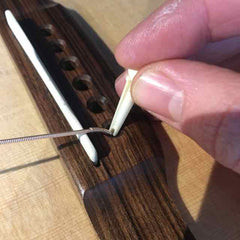 Creating a 45-degree bend at the ball end of a guitar string
Creating a 45-degree bend at the ball end of a guitar string
Step 9: Secure the String at the Bridge
Insert the ball end of the string into the bridge hole. Place the bridge pin on top, ensuring the string tail sits in the pin’s groove and that the groove points towards the soundhole. Push the pin firmly into place to secure the string.
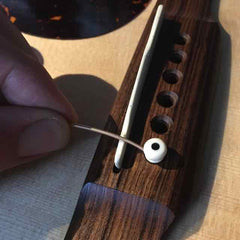 Inserting the ball end of a guitar string and securing it with a bridge pin
Inserting the ball end of a guitar string and securing it with a bridge pin
Step 10: Repeat for Remaining Bridge Pins
Repeat steps 8 and 9 for the remaining five strings. After inserting all the strings, gently pull on the tail of each string to ensure the ball end is firmly seated against the bottom of the bridge plate inside the guitar.
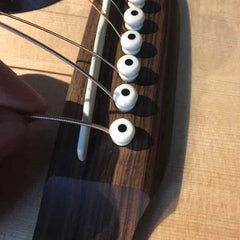 All six bridge pins inserted, securing the new guitar strings at the bridge
All six bridge pins inserted, securing the new guitar strings at the bridge
Step 11: Prepare the Tuning Pegs
Make sure the holes in each machine head (tuning peg) are aligned straight down the neck. This will make string insertion easier.
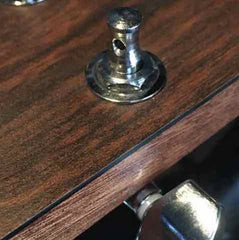 Tuning pegs aligned straight down the guitar neck before string insertion
Tuning pegs aligned straight down the guitar neck before string insertion
Step 12: Thread the String Through the Tuning Peg
Bring the string over the saddle and nut, and then thread it through the hole in the corresponding tuning peg.
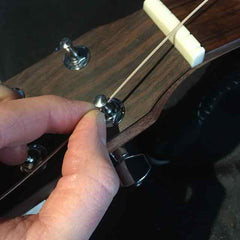 Threading a guitar string through the tuning peg
Threading a guitar string through the tuning peg
Step 13: Measure and Cut Excess String
Pull the string taut and measure approximately two tuning pegs past the current tuning peg. This length will provide enough string for several winds around the tuning post, which enhances tuning stability.
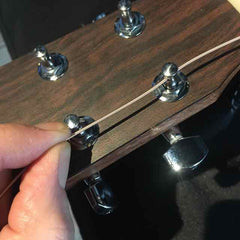 Measuring the guitar string length past the tuning peg for winding
Measuring the guitar string length past the tuning peg for winding
Step 14: Begin Winding the String
Pull the excess string back through the tuning peg and begin winding counter-clockwise for the lower strings (E, A, D) and clockwise for the higher strings (G, B, e). Maintain tension on the string as you wind to keep the measured length consistent. The string should wind downwards towards the headstock.
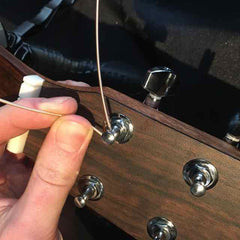 Winding the guitar string around the tuning peg in the correct direction
Winding the guitar string around the tuning peg in the correct direction
Step 15: Ensure Proper String Winding
As you wind, ensure the new wraps of string are below the previous wraps, pushing them downwards. This creates a neat and effective winding that improves tuning stability.
 Close-up of proper guitar string winding technique on the tuning peg
Close-up of proper guitar string winding technique on the tuning peg
Step 16: Tighten and Trim
Continue tightening the string until there is a slight amount of tension. A couple of winds around the post should be sufficient at this stage. Take your wire cutters and trim off the excess string as close to the tuning peg as possible for a clean look and to prevent string ends from poking you.
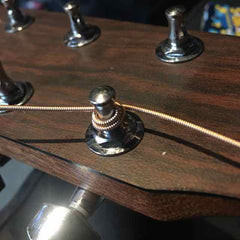 Trimming excess guitar string after winding around the tuning peg
Trimming excess guitar string after winding around the tuning peg
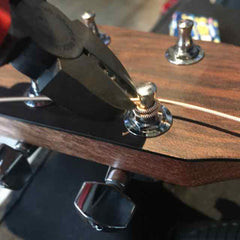 Neatly trimmed guitar string ends at the tuning pegs
Neatly trimmed guitar string ends at the tuning pegs
Step 17: Repeat for All Strings
Repeat steps 12-16 for the remaining five strings, working from thickest to thinnest.
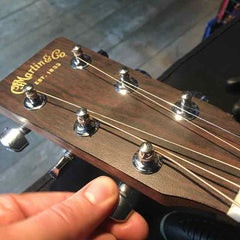 All six new guitar strings installed and trimmed at the tuning pegs
All six new guitar strings installed and trimmed at the tuning pegs
Step 18: Tune Your Guitar
Once all strings are installed, use a tuner to bring them up to the correct pitch. Tune gradually, moving back and forth between strings to distribute tension evenly across the neck. A clip-on tuner can be very helpful for this.
 Using a clip-on tuner to tune newly installed guitar strings
Using a clip-on tuner to tune newly installed guitar strings
Step 19: Stretch the Strings
New strings need to be stretched to maintain their tuning. Gently stretch each string by pulling it away from the fretboard along its length. Retune after stretching. Repeat this process a few times until the strings hold their pitch consistently. This step is vital for tuning stability and will save you time retuning later.
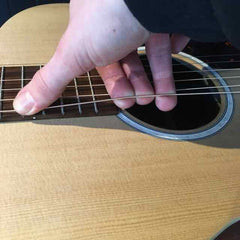 Stretching new guitar strings to improve tuning stability
Stretching new guitar strings to improve tuning stability
Step 20: Final Tuning and Play!
After stretching, perform a final tuning. Your guitar is now restrung and ready to play! Regular restringing, along with proper technique, will keep your guitar sounding its best and enhance your playing experience. Enjoy your freshly restrung guitar!
